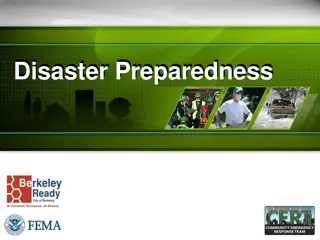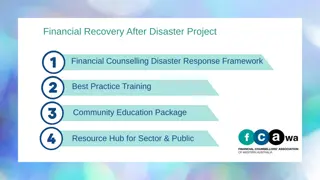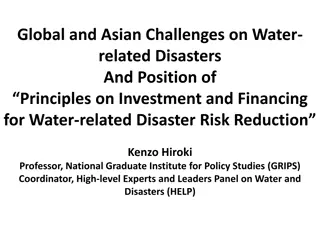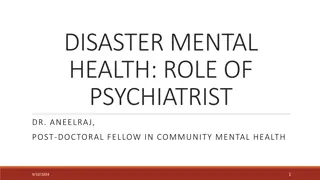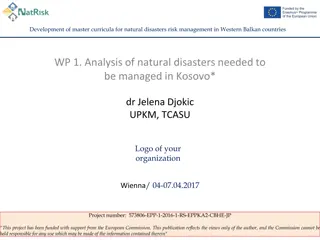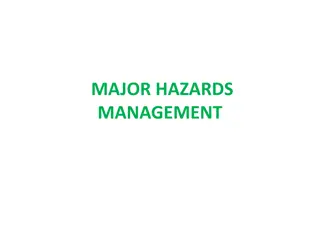Understanding Floods: Major Hazards and Disasters in Environmental Geography and Disaster Management
Floods, a common natural disaster, are often caused by factors like intense rainfall, river overflow, and human activities. Regions in India, such as Assam and Bihar, face significant loss due to recurrent floods. Factors like skewed rainfall patterns and transnational rivers contribute to the flooding crisis. Improved management practices and understanding of flood causes are crucial for mitigating the impact of these disasters.
Download Presentation

Please find below an Image/Link to download the presentation.
The content on the website is provided AS IS for your information and personal use only. It may not be sold, licensed, or shared on other websites without obtaining consent from the author. Download presentation by click this link. If you encounter any issues during the download, it is possible that the publisher has removed the file from their server.
E N D
Presentation Transcript
4thSemester Paper-4016 ENVIRONMENTAL GEOGRAPHY AND DISASTER MANAGEMENT
MAJOR HAZARDS AND DISASTERS *FLOOD Floods are an overflow or inundation that comes from a river or other body of water and often threatens lives and properties. Therefore, any relatively high streamflow overtopping natural or artificial banks (e.g., levees) in any reach of a stream can be termed a flood. Floods can happen when the flow capacity of river channels, streams, or coastal areas is exceeded due to heavy, intense, or continuous rainfall or when the absorptive capacity of the soils is exceeded. Floods are relatively slow in occurrences and often occur in well identified regions and within expected time in a year. Floods occur commonly when water in the form of surface run- off exceeds the carrying capacity of the river channels and streams and flows into the neighbouring low-lying flood plains.
Sometimes this even goes beyond the capacity of lakes and other inland water bodies in which they flow. Floods can also be caused due to a storm surge, high intensity rainfall for a considerably longer time period, melting of ice and snow, reduction in the infiltration rate and presence of eroded materials in the water due to higher rate of soil erosion. Unlike other natural disasters human beings play important role in the genesis as well as spread of floods. Indiscriminate deforestation, unscientific agricultural practices, disturbances along the natural drainage channels and colonisation of flood plains and river beds are some of the human activities that play an important role in increasing the intensity, magnitude and gravity of the floods.
Various states of India face heavy loss of lives and property due to recurrent floods. National Flood Commission has identified 40 million hectares of land as flood prone in India. Assam, West Bengal and Bihar are among the high flood prone states. Apart from these, most of the rivers in the northern states like Uttar Pradesh and Punjab are also vulnerable to frequent floods. States like Rajasthan, Gujarat, Haryana and Punjab are also getting inundated in recent years due to flash floods. This is partly because of the pattern of monsoon and partly because of blocking of most of the streams and rivers by human activities. Sometimes Tamil Nadu experiences flooding during November- January due to retreating monsoon.
Natural Causes Skewed Rainfall Pattern: 80% of the precipitation takes place in the monsoon months from June to September. During this time, the rivers bring heavy sediment load from the catchments.. These, coupled with inadequate carrying capacity of the rivers and drainage congestion and erosion of river-banks are responsible for causing floods. Trans-National Rivers: The fact that some of the rivers (like Brahmaputra, many tributaries of Ganga) causing damage in India originate in neighboring countries, adds another complex dimension to the problem. Also, sudden change in topography from high mountains to plain areas, is also a reason for floods in northern India. Earthquakes: An Earthquake Disaster Risk Index (EDRI), prepared by the National Disaster Management Authority (NDMA), showed that about 56% area of India is vulnerable to moderate to major earthquakes. As many of the river basins in India lie in earthquake-prone areas, the course of the river is not stable and amounts to flooding
Human Causes Unplanned Development: Unplanned development, encroachments in riparian zones, failure of flood control structures, unplanned reservoir operations, poor drainage infrastructure, deforestation, land use change and sedimentation in river beds are exacerbating floods. When rainfall is heavy, the river breaches the embankments and destroys habitations along the banks and on the sandbars. Urban Flooding: Flooding in the cities and the towns is a recent phenomenon caused by increasing incidence of heavy rainfall in a short period of time. The reason for this is indiscriminate encroachment of waterways and wetlands, inadequate capacity of drains and lack of maintenance of the drainage infrastructure.
Neglect of Pre-Disaster Planning: History of flood management shows that focus of disaster management has largely been on post- flood recovery and relief.Many reservoirs and Hydro-electric plants do not have enough gauging stations for measurement of flood level, which is the principal component for flood prediction and forecast. Disaster Preparedness Plan:A comprehensive flood management plan is needed to include Disaster preparedness.This may require strengthening of the following:Flood Hotspot Mapping at local and regional scale. Management and regulation of riparian zones to prevent spilling and erosion. River flood modelling to prepare for incidences like reservoir breach and emergency water release from dams. Advanced techniques such as mapping based on satellite imagery and Geographic Information Systems will help in development of flood early warning systems
Integrated Approach: Steps need to be taken for watershed management through an integrated approach. Often these approaches involve both hard engineering solutions and ecologically sustainable soft solutions. Hard Solutions: It involves civil engineering construction such as dams, culverts and dykes, widening and deepening of river channels and diversion channels to store and divert water to increase the lag time of water reaching downstream. Ecological Soft Solutions: The solutions such as restoration and management of riparian zones, afforestation along the river channels which led to retention of rainwater and reduces the river discharge. An integrated approach to managing floods requires a sound understanding of the patterns that rivers such as the Ganga and its tributaries display during the monsoon.
Prioritising Buffers, Flexibility and Adaptability: This includes reviewing safety criteria of dams and canals, re-building these with higher safety factors, creating new intermediate storages, and introducing dynamic reservoir management. Reducing Disaster Risk Reduction: There is a need for efficient implementation of Sendai Framework for Disaster Risk Reduction,this will reduce the vulnerability of any disaster. Focusing on Urban Flood Management: Keeping in view the fact that the problem of Urban Flooding is becoming more severe and losses are mounting every year. The subject of urban flooding needs exclusive attention and the proper implementation of NDMA guidelines on Urban Flooding 2016, is the need of the hour NDMA Guideline Observation Networks, Information Systems, Monitoring, Research, Forecasting & Early Warning: Preparation of close contour and flood vulnerability maps Modernisation of flood forecasting and warning systems on a river basin basis
Assist states/UTs in the identification of priority flood protection and drainage improvement works Monitoring of flood preparedness, river basin and reservoir management plans Studies and monitoring of rivers flowing from neighbouring countries Studies involving international cooperation for forecasting and cross border issues Implementation of the schemes for real-time collection of hydro- meteorological data on important rivers including the relevant rivers flowing from Nepal, Bhutan and China Specialised efforts for different types of floods and causes of flooding, including cloudburst Developing/ improving/ updating forecasting methods and models for quantification of inflows and storage of dams.
Zoning, mapping, and classification flood prone areas: Preparation of large-scale hazard maps of flood prone areas identifying areas of high vulnerability. Research and Development: Studies on support systems for people living in flood prone areas Evolving designs of shelters in flood prone areas Socio-economic impacts of flood River basin studies Studies on flood related problems such as soil losses caused by flooding of rivers, sediment transport, river course changes, and appropriate use of embankments Promote research and studies both in-house and extra-mural by providing research grants to researchers and institutions
Hydrological and morphological studies before undertaking major flood control or prevention measures. Dissemination of warnings, data, and information: Quick, clear, effective dissemination among central and state agencies Facilitate the distribution of necessary communication equipment, last-mile connectivity and access to disaster risk information International cooperation to share warnings about rivers flowing from neighbouring countries Promoting reliable networking systems for data and information sharing among central and state agencies Monitoring of landslides and blockages in rivers Warning systems Providing information in all possible ways and using all types of media Interface with mobile network service providers for warnings. Inter-agency coordination: Effective coordination and seamless communication among central and state agencies to ensure quick, clear, effective dissemination of warnings, information and data.
Structural Measures: Flood control measures such as construction of embankments and levees. Proper alignment and design of Waterways and drainage systems for roads, highways, and expressways. Enhancing the safety of dams and reservoirs. Desilting/ dredging of rivers to improve flow; drainage improvement; floodwater diversion through existing or new channels. Hazard resistant construction, strengthening, and retrofitting of all lifeline structures and critical infrastructure. Awareness Generation: Carry out mass media campaigns Promote culture of disaster risk prevention, mitigation, and beer risk management Promote attitude and behaviour change in the awareness campaigns/ IEC Strengthening network of civil society organization for awareness generation about DRR and DM
Promote use of insurance/ risk transfer Promote Community Radio Mock drills or exercises: Promote planning and execution of emergency drills by all ministries and in all States/UT s Vocational Training/ Skill Development: Promoting skill development for multi-hazard resistant construction in flood-prone areas for different types of housing and infrastructure. Empowering women, marginalised communities and persons with disabilities: Incorporating gender sensitive and equitable approaches in capacity development covering all aspects of disaster management.
Community-Based Disaster Management Training for PRI, SHG, NCC, NSS, youth, local community organizations Strengthen ability of communities to manage and cope with disasters based on a multi-hazard approach As floods cause major damage to life and property every year, it is time the central and the state governments prepare a long-term plan that goes beyond piecemeal measures like building embankments and dredging to control floods. Also, there is a need for an integrated basin management plan that brings all the river- basin sharing countries as well Indian states on board Source:Environmental geography,Savindra Singh NDMA website






